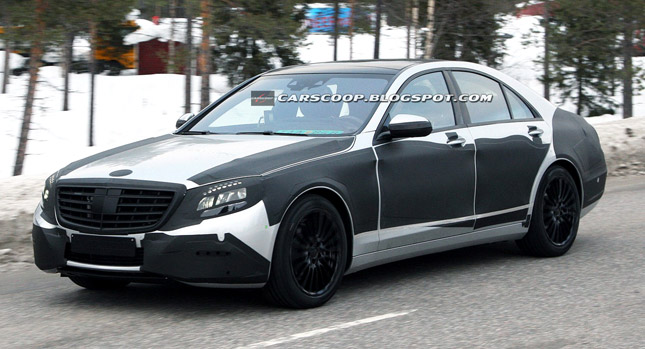After posting new records for vehicle sales, revenue and earnings in 2011 and with 2012 off to a good start as the company is expected to report its best sales ever in a first quarter, Mercedes-Benz has every reason to be optimistic about the future, despite some hiccups such as the axing of the Maybach brand.
During the opening ceremony of a new plant in Kecskemét, Hungary, Dieter Zetsche, Chairman of Daimler AG and head of Mercedes-Benz Cars, outlined the company’s 2020 growth strategy.
 Zetsche said that the Mercedes-Benz cars division intends to conquer the number one position in the premium segment not only in terms of brand, products and profitability, but also of vehicle sales.
Zetsche said that the Mercedes-Benz cars division intends to conquer the number one position in the premium segment not only in terms of brand, products and profitability, but also of vehicle sales.
Overall, worldwide car sales are forecasted to increase from 60 million units in 2011 to 100 million units in 2020. According to Zetsche, Mercedes-Benz’s medium-term target target is to lift sales from 1,279,100 in 2011, to more than 1.5 million vehicles in 2014 and more than 1.6 million in 2015.
Zetsche stated that Mercedes-Benz will broaden its customer base and address younger customers with the presentation of five new compact models as well as with what he describes as “highly emotive vehicles” such as the upcoming CLS Shooting Brake.
In the next 3 years, Mercedes plans to launch 10 new derivatives for which no predecessor models exists today.
As an example, Zetsche said that the next S-Class’ range will expand “from three to six models with highly profitable derivatives”.
We’re not sure what Zetsche means by the three S-Class models as the current series has two body styles – the standard and long-wheelbase variants, unless Mercedes also includes the CL, which will be renamed to the S-Class Coupe in its next generation. Aside from the coupe, the next S-Class is believed to include a special, more luxurious “Pullman” variant and possibly a convertible.
The firm’s planned activities also include further reductions in fuel consumption and CO2 emissions. “We are convinced that ‘cool’ and ‘green’ can peacefully coexist in our garages,” said Zetsche. The Germany company aims to lower the average CO2 emissions of its automobiles sold in Europe from today’s 150 g/km to 125 g/km by 2016.
To further increase sales, Mercedes will expand its portfolio and production capacities in the NAFTA (North American Free Trade Agreement) region and in China.
Zetsche added that Mercedes will also improve its profitability by means of project-related cooperation such as with the Renault-Nissan Alliance, as well as through savings achieved from the module and platform strategies and improved efficiency in the value chain.
“At Mercedes-Benz Cars, we are approaching our targeted return on sales of 10 percent, which we want to achieve on a sustained basis as of 2013 – on the assumption that our business environment will remain stable,” stated Zetsche.
PHOTO GALLERY




![2013-Mercedes-CLS-63-AMG-Shooting Brake-1[3] 2013-Mercedes-CLS-63-AMG-Shooting Brake-1[3]](https://www.carscoops.com/wp-content/uploads/2012/03/f637ba56-2013-mercedes-cls-63-amg-shooting252520brake-125255b325255d_thumb.jpg)
![2013-Mercedes-CLS-63-AMG-Shooting Brake-3[3] 2013-Mercedes-CLS-63-AMG-Shooting Brake-3[3]](https://www.carscoops.com/wp-content/uploads/2012/03/c8c8f612-2013-mercedes-cls-63-amg-shooting252520brake-325255b325255d25255b225255d-300x163.jpg)
![2013-Mercedes-CLS-63-AMG-Shooting Brake-5[3] 2013-Mercedes-CLS-63-AMG-Shooting Brake-5[3]](https://www.carscoops.com/wp-content/uploads/2012/03/3d0f90c6-2013-mercedes-cls-63-amg-shooting252520brake-525255b325255d25255b225255d-300x163.jpg)
![2013-Mercedes-CLS-63-AMG-Shooting Brake-7[3] 2013-Mercedes-CLS-63-AMG-Shooting Brake-7[3]](https://www.carscoops.com/wp-content/uploads/2012/03/fd65816b-2013-mercedes-cls-63-amg-shooting252520brake-725255b325255d25255b225255d-300x163.jpg)
![2013-Mercedes-Benz-Citan-Van-1[3] 2013-Mercedes-Benz-Citan-Van-1[3]](https://www.carscoops.com/wp-content/uploads/2012/03/87ebcf4f-2013-mercedes-benz-citan-van-125255b325255d25255b225255d-300x163.jpg)
![2013-Mercedes-Benz-Citan-Van-2[3] 2013-Mercedes-Benz-Citan-Van-2[3]](https://www.carscoops.com/wp-content/uploads/2012/03/155d860d-2013-mercedes-benz-citan-van-225255b325255d25255b225255d-300x163.jpg)
![2013-Mercedes-Benz-Citan-Van-4[3] 2013-Mercedes-Benz-Citan-Van-4[3]](https://www.carscoops.com/wp-content/uploads/2012/03/f5bd557c-2013-mercedes-benz-citan-van-425255b325255d25255b225255d-300x163.jpg)
![2014-Mercedes-Benz-S-Class-1[3] 2014-Mercedes-Benz-S-Class-1[3]](https://www.carscoops.com/wp-content/uploads/2012/03/545a8ff1-2014-mercedes-benz-s-class-125255b325255d25255b225255d-300x163.jpg)
![2014-Mercedes-Benz-S-Class-2[3] 2014-Mercedes-Benz-S-Class-2[3]](https://www.carscoops.com/wp-content/uploads/2012/03/0068c136-2014-mercedes-benz-s-class-225255b325255d25255b225255d-300x163.jpg)
![2014-Mercedes-Benz-S-Class-4[3] 2014-Mercedes-Benz-S-Class-4[3]](https://www.carscoops.com/wp-content/uploads/2012/03/e4e99d3e-2014-mercedes-benz-s-class-425255b325255d25255b225255d-300x163.jpg)
![2014-Mercedes-Benz-S-Class-5[3] 2014-Mercedes-Benz-S-Class-5[3]](https://www.carscoops.com/wp-content/uploads/2012/03/a086605c-2014-mercedes-benz-s-class-525255b325255d25255b225255d-300x163.jpg)
![2014-Mercedes-Benz-S-Class-6[3] 2014-Mercedes-Benz-S-Class-6[3]](https://www.carscoops.com/wp-content/uploads/2012/03/2bebc28b-2014-mercedes-benz-s-class-625255b325255d25255b225255d-300x163.jpg)
![2014-Mercedes-Benz-C-Class-Sedan-1[3] 2014-Mercedes-Benz-C-Class-Sedan-1[3]](https://www.carscoops.com/wp-content/uploads/2012/03/f47a90d5-2014-mercedes-benz-c-class-sedan-125255b325255d25255b225255d-300x163.jpg)
![2014-Mercedes-Benz-C-Class-Sedan-6[3] 2014-Mercedes-Benz-C-Class-Sedan-6[3]](https://www.carscoops.com/wp-content/uploads/2012/03/4aa761a7-2014-mercedes-benz-c-class-sedan-625255b325255d25255b225255d-300x163.jpg)
![2014-Mercedes-Benz-C-Class-Sedan-7[3] 2014-Mercedes-Benz-C-Class-Sedan-7[3]](https://www.carscoops.com/wp-content/uploads/2012/03/d36708e1-2014-mercedes-benz-c-class-sedan-725255b325255d25255b225255d-300x163.jpg)
![2014-Mercedes-Benz-C-Class-Sedan-3[3] 2014-Mercedes-Benz-C-Class-Sedan-3[3]](https://www.carscoops.com/wp-content/uploads/2012/03/61e7e3c3-2014-mercedes-benz-c-class-sedan-325255b325255d25255b225255d-300x163.jpg)
![2013-Mercedes-A-Class-hatch-8[2] 2013-Mercedes-A-Class-hatch-8[2]](https://www.carscoops.com/wp-content/uploads/2012/03/a7af3577-2013-mercedes-a-class-hatch-825255b225255d25255b225255d-300x163.jpg)
![2013-Mercedes-A-Class-hatch-7[2] 2013-Mercedes-A-Class-hatch-7[2]](https://www.carscoops.com/wp-content/uploads/2012/03/da8bbfc4-2013-mercedes-a-class-hatch-725255b225255d25255b225255d-300x163.jpg)
![2013-Mercedes-A-Class-hatch-5[2] 2013-Mercedes-A-Class-hatch-5[2]](https://www.carscoops.com/wp-content/uploads/2012/03/10b199b0-2013-mercedes-a-class-hatch-525255b225255d25255b225255d-300x163.jpg)
![2013-Mercedes-A-Class-hatch-4[2] 2013-Mercedes-A-Class-hatch-4[2]](https://www.carscoops.com/wp-content/uploads/2012/03/22e891ff-2013-mercedes-a-class-hatch-425255b225255d25255b225255d-300x163.jpg)
![2013-Mercedes-A-Class-hatch-6[2] 2013-Mercedes-A-Class-hatch-6[2]](https://www.carscoops.com/wp-content/uploads/2012/03/62810188-2013-mercedes-a-class-hatch-625255b225255d25255b225255d-300x163.jpg)
![2013-Mercedes-A-Class-hatch-3[2] 2013-Mercedes-A-Class-hatch-3[2]](https://www.carscoops.com/wp-content/uploads/2012/03/87732d73-2013-mercedes-a-class-hatch-325255b225255d25255b225255d-300x163.jpg)
![2013-Mercedes-A-Class-hatch-1[2] 2013-Mercedes-A-Class-hatch-1[2]](https://www.carscoops.com/wp-content/uploads/2012/03/d9edc306-2013-mercedes-a-class-hatch-125255b225255d25255b225255d-300x163.jpg)
![2012-Mercedes-Benz-A-Class-1[2] 2012-Mercedes-Benz-A-Class-1[2]](https://www.carscoops.com/wp-content/uploads/2012/03/00e2687c-2012-mercedes-benz-a-class-125255b225255d25255b225255d-300x163.jpg)
![2013-Mercedes-A-Class-hatch-14[2] 2013-Mercedes-A-Class-hatch-14[2]](https://www.carscoops.com/wp-content/uploads/2012/03/733eee65-2013-mercedes-a-class-hatch-1425255b225255d25255b225255d-300x163.jpg)













